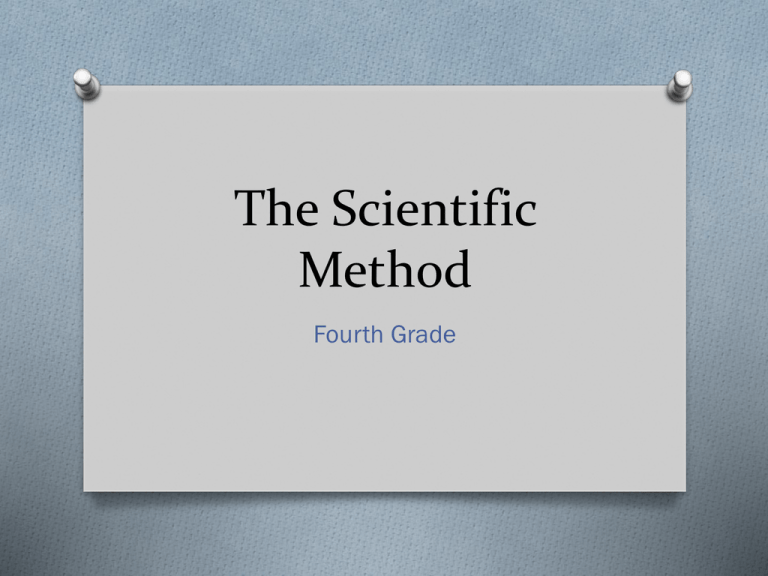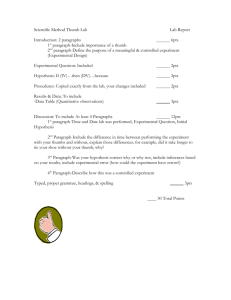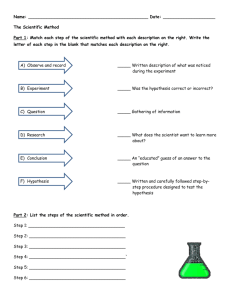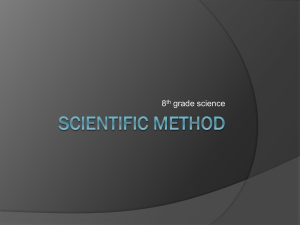The Scientific Method
advertisement

The Scientific Method Fourth Grade What to Expect O You will have 5 days of active instruction on the scientific method. O You will have 1 review day after we complete instruction. O You will take a quiz on what you have learned. You will be creating study tools along the way. Let’s get started! Day One In your groups, you will conduct an experiment. Guess O There is a legend that says that you cannot fold a paper in half more than 7 times. O Do you think it can be done? Discuss with your group if you think you can fold a piece of paper in half more than 7 times. Write your guess down on a piece of paper. You have 5 minutes to make your prediction. Experiment O In your table groups, you have three types of paper: copy paper, construction paper, and tissue paper. Work together to see if you can fold each type of paper in half more than 7 times. O You have 15 minutes. Remember…the paper must be folded in HALF each time. Results O Raise your hand if you were able to fold the construction paper in half more than 7 times. O Raise your hand if you were able to fold the copy paper in half more than 7 times. O Raise your hand if you were able to fold the tissue paper in half more than 7 times. O Discuss the results with your group. Write down why you think you had these results. You have 15 minutes. Steps O What steps did you take to fold each paper? Did you fold it hot dog style or hamburger style first? Which paper type did you start with? O In your groups, write down your steps for each type of paper. You have 20 minutes. Research O Watch this video to see the Myth Busters fold a paper more than 7 times… Myth Busters Paper Folding Conclusion O Why do you think you were successful/unsuccessful? O Discuss this question with your group and write it down. You have 10 minutes. Day Two O What is the Scientific Method? O The Scientific Method is a way to ask and answer scientific questions by making observations and doing experiments. O The steps of the Scientific Method are: 1. Ask a question 2. Do background research 3. Construct a hypothesis 4. Test your hypothesis by doing an experiment 5. Analyze your data and draw a conclusion 6. Communicate your results What is a fair test? O It is important for your experiment to be a “fair test”. A fair test occurs when you change only one factor (variable) and all other aspects of the experiment are the same (constant). O What was our variable in yesterday’s activity? What were the constants? Turn and Talk with your group. You have 5 minutes to discuss. Why? O The Scientific Method is an ongoing process, which usually begins with observations about the natural world. As humans, we love to ask questions about the world around us! O Why do I need to learn about the Scientific Method? Fourth graders are required to participate in the Science Fair. We are teaching you how to conduct your experiment here at school so that you can be prepared to complete it at home. Key Words O Purpose – state the problem O Analysis – record the results of the experiment O Hypothesis – predict the outcome of the problem O Conclusion – compare the hypothesis to the results O Research – find out about the topic O Experiment – develop a procedure to test the hypothesis Activity O You are going to create a fact flipper to help you remember the key words you have learned in this lesson. O You will need: scissors, glue, and a pencil. O The teacher will demonstrate how to construct your fact flipper. Make sure you pay attention! Day Three O Breaking it down! The Question O The Scientific Method starts with a question (purpose). This might be based on an observation you have made or a particular topic that interests you. Think about what you hope to discover during your investigation. What question would you like to answer? Your question needs to be about something you can measure and will typically start as what, when, where, how, or why. Background Research O Talk to adults and use resources (e.g., books, internet) to perform background research on your question. Gathering information now will help you prepare for the next step in the Scientific Method. Hypothesis O A hypothesis is an “educated guess”. Using your background research and current knowledge, make an educated guess that answers your question. Your hypothesis should be a simple statement that expresses what you think will happen. Experiment O Create a step-by-step procedure (or process) and conduct an experiment that tests your hypothesis. The experiment should be a fair test that changes only one variable at a time while keeping everything else the same. Repeat the experiment a number of times to ensure your original results weren’t an accident. Data O Collect data and record the progress of your experiment. Document results with detailed measurements, descriptions, and observations in the form of notes, journal entries, photos, charts, and graphs. Observations O Describe the observations you made during your experiment. Include information that could have affected your results such as errors, environmental factors, and unexpected surprises. Conclusions O Analyze the data you collected and summarize your results in written form. Use your analysis to answer your original question, do the results of your experiment support or oppose your hypothesis? Communication O Present your findings in an appropriate form, whether it’s a final report for a scientific journal, a poster for school, or a display board for a science fair competition. Activity O We are going to do an experiment! O Question: “Will this ball bounce higher on the tile floor or the carpet floor?” O Turn and Talk to a neighbor in your group. What do you think the answer to the question is? O In your groups, develop a hypothesis. You have five minutes to create a one-sentence prediction. Activity O We are going to conduct a very brief experiment to test our hypothesis and find an answer to our question! O Each group needs one note-taker. O I am going to bounce the ball three times on each surface. The note-takers will write down what they observe. O We will record our results on the board. Constants vs. Variables O Remember, we need to conduct a “fair test”. O Constants – keep everything the same; also commonly referred to as the control O What are some constants we can keep in our experiment? O Variable – pick ONE thing to change O What can our variable be in our experiment? Conclusion O Look at the results of our experiment. Did the results match your team’s hypothesis? O Turn and Talk in your groups to compare the results to the hypothesis. You have 5 minutes. Day Four O Today, we are going to dig a little deeper! O Let’s watch a video to help us remember the steps of the Scientific Method! O The Scientific Method Rap Key Vocabulary O Model – smaller objects built to represent larger O O O O objects Procedure – a series of steps in an experiment Observation – the use of your senses to obtain data from your environment Predict – to forecast or generalize about future events Reaction – a response to a treatment, solution, or stimulus Activity O You will create another fact flipper with your new vocabulary. O You will need scissors, glue, a pencil, and you may want coloring supplies for the illustrations. O This time, you will need to match the vocabulary word by gluing it under the correct definition flap. O You may use the previous slide to assist you. Day Five O Review The Scientific Method Rap (see slide 27) O Review the steps of the Scientific Method Turn and Talk Time O Turn and Talk to a partner in your group and discuss the 1. 2. 3. 4. 5. 6. 7. following questions. Write your answers on one piece of paper. Your answers do NOT have to be in complete sentences this time! What do we call the steps used during an experiment? What is the vocabulary word used to describe an educated guess? What is the part of an experiment that is not being tested and is used for comparison (stays the same, another word for constant)? What helps scientists make a hypothesis or collect data during an experiment? What is the first step of the scientific method? What is the summary of an experiment and its results? What is the information collected during an experiment? Turn and Talk Answers 1. Processes OR Procedure 2. Hypothesis 3. Control 4. Observations 5. Problem 6. Conclusion 7. Data Activity O Complete The Scientific Method Crossword Puzzle. This will be for a classwork grade. You will need to complete this independently. Day Six O Let’s make sure we really understand! Thumbs Up, Thumbs Down O If the statement is true, please hold your thumb up. If the statement is false, please hold your thumb down. Are you ready? 1. You must state the problem before developing a procedure. Answer: Thumbs Up! Thumbs Up, Thumbs Down 2. Measurement does not help scientists to compare objects. Answer: Thumbs Down! How else can they tell if a plant grew faster in a certain type of soil? Thumbs Up, Thumbs Down 3. Your sense of smell helps you associate odors with objects. Answer: Thumbs Up! Thumbs Up, Thumbs Down 4. Scientists use current observations to predict future events. Answer: Thumbs Up! If it’s raining today, it’s likely that it’ll rain again some time in the future! Thumbs Up, Thumbs Down 5. Research is the fourth step in the scientific method. Answer: Thumbs Down! Research is the second step in the scientific method! Thumbs Up, Thumbs Down Last one! 6. The scientific experiment may also be called the hypothesis. Answer: Thumbs Down! The scientific experiment may also be called the procedure. Assessment Time O Tomorrow, we will play a game to review what you’ve learned about the Scientific Method. O The day after our review day, we will take a quiz on what you’ve learned. Use your fact flippers to help you study for the quiz!







